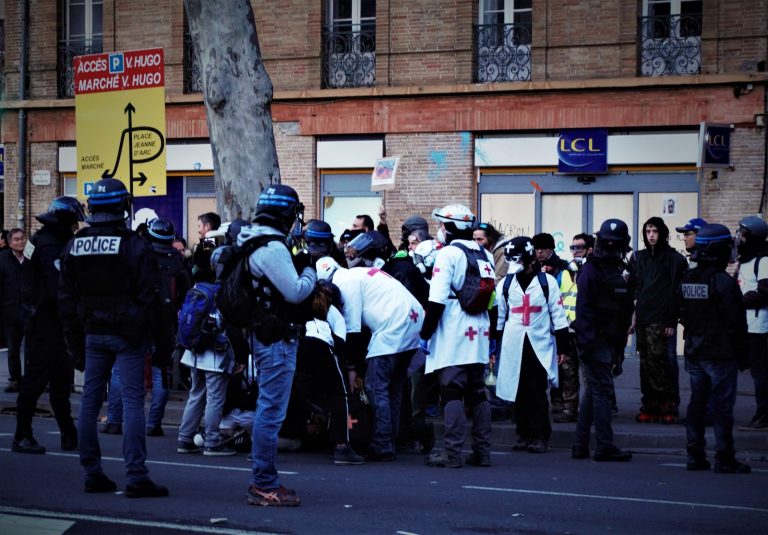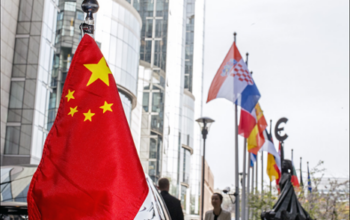“He knew that the maintenance of order obeyed strict rules, dictated by political power. No police was as submissive to the State as that of M.O., it incarnated the State in its essence. The order that is to be maintained or re-established, is always that of the State. […] the affair was political […]” – David Dufresne (Dernière sommation)
Shortly after the Gilets Jaunes movement began, the journalist David Dufresne started to keep track of injuries inflicted on protesters, medics and journalists by the police during the weekly protests. The statistics are sobering, the visual images circulating online – including photos and videos of head wounds, protesters being targeted with rubber bullets at close distance, violent interpellations, and protesters losing an eye or a hand due to the so-called “less-lethal” weapons used by the police – are horrifying.
Police violence does not, however, exist only since the beginning of the Gilets jaunes protests, nor only in France where, according to a video, created by multiple people and collectives, featuring journalists, activists and lawyers, 578 people have been killed by the police within the last 42 years, 12% of them aged under 18. Police violence might be more pronounced in France due to factors such as the police forces use of weapons (LBD 40, GLI F4, GMD) that are not used in most other European countries and the presence of the BAC (anti-criminality brigade) at protests even though they are not specialised in keeping public order. However, instances of police violence and disproportional use of force are very real – if to a lesser extent – in other EU countries, as well. The disproportionate use of pepper spray and water cannons against Stuttgart 21 protesters in Germany in 2010, violence against Extinction Rebellion activists in Brussels in October 2019 and the response to the Catalan independence movement are further examples.

“No irreparable violence”
The problem with police violence does not stop at the damage done but extends to the manner in which is dealt with its occurence. The French government point blank denies the existence of police violence, or even reinforces it through policy measures such as the loi anti-casseur passed earlier this year. “Do not talk to me of repression or police violence, these words are unacceptable in a constitutional state”, commented President Macron on one occasion during his grand débat. And Interior Minister Castaner claimed to “not know of any police officer who has attacked Gilets jaunes.“
More recently, Macron said: “No irreparable violence has been committed by the police.” However, the loss of an eye or a hand are very much irreparable. Not to speak of two recent incidents which led to the death of Zineb Redouane (Marseille, December 2018) and Steve Maia Caniço (Nantes, June 2019). Rather than “no irreparable” damage being caused by the police, it is the case that the responsibility for the harm done is lifted from them.

The death of Zineb Redouane
On December 1, 2018, Zineb Redouane, aged 80, went to close the window of her apartment in Marseille to prevent tear gas from the protest happening outside entering the flat. She was hit in the face by parts of a tear gas grenade and died the next day in hospital. Following the incident both Interior Minister Castaner and the responsible prosecutor declared that no link could be established between her death and the injuries caused by the tear gas grenade.
The prosecutor based his statement on the autopsy performed in Marseille on December 3. After Zineb Redouane’s body was repatriated to Algeria, her home country, local authorities performed a second autopsy that concluded a direct causal relation between her death and the injuries inflicted on her on December 1. In July 2019, it was revealed that the CRS officer in charge on the day of her death received a medal from the Interior Minister for his work as a police officer, aggravating the grief and anger of her family.
The inquiry into the circumstances of her death did not establish a basis for justice. The five CRS grenade launchers used near Zineb Redouane’s home on December 1 were not confiscated, the officers using the grenade launchers stated that they could not remember who fired the grenade responsible for the injuries and neither were they able to identify the shooter in video footage. The police officers’ radio exchanges went missing, and the only security camera present apparently malfunctioned.
Selon l’IGPN
In the night from 21 to 22 June, 24-year old Steve Maia Caniço went missing following a police charge at the fête de la Musique, a free party in Nantes, during which 33 tear gas grenades, 10 sting-ball grenades and 12 flash balls were used against the party-goers without warning and resulted in 14 people falling into the Loire. More than a month later, on 29 July, Steve Maia Caniço’s body was found in the river. The following day, Prime Minister Philippe announced that based on the report of a general inspection of the National Police (IGPN), the “police of the police”, no link could be established “between the police intervention and the death of Mr Steve Maia Caniço.“
The reaction to this statement on social media followed soon after. Using the hashtag #selonlIGPN (according to the IGPN), people expressed their indignation at the denial of responsibility pointing out the absurdity of the report’s conclusion. Comments ranged from “we could not establish a link between the intervention of the Prime Minister and the truth, either” to “#selonlIGPN no link could be established between the atomic bomb and Hiroshima.” And indeed, some time later more information was released to the public and generated even more doubt on the accurateness of the inquest. According to mediapart, accounts of witnesses confirming that they had fallen into the Loire since they were unable to see due to the tear gas as they tried to get away from the police were left out. Moreover, the IGPN used Steve Maia Caniço’s last text message, sent at 3:16 am, to conclude that he must have fallen into the river before the police intervention, whereas according to Le canard enchainé his phone continued to transmit signals until 4:33 am, that is, after the police intervention had begun.

Justice and responsibility
The existence of police violence cannot be denied and those who are responsible are rarely held accountable. A statistic published by the University Bochum and the Federal Statistical Office shows that 91 percent of the cases of police violence in Germany in 2017 were dropped, and only 2 percent were followed by charges or a penal order. More often than not filing charges against a police officer leads to being charged with resistance against an executory officer.
So, what are the alternatives to police investigating police – or, in fact, failing to do so properly? In Germany, Die Linke (left-wing party) suggested the establishment of an independent office processing complaints against police officers. Similarly, in France, there are voices being raised demanding the replacement of the IGPN with a more independent commission tasked with inquiries into the police force. Of course, the improvement of such procedures and institutions alone will not eradicate police violence but it might well be a first step towards reducing it.
by Merle Emrich
Photo Credits
Police (Toulouse), Merle Emrich, All Rights Reserved
Flashball, Merle Emrich, All Rights Reserved
Streetmedics (Toulouse) 19/01/2019, Merle Emrich, All Rights Reserved
La fresque en hommage à Steve Maia Caniço sur le quai Wilson à Nantes – Août 2019, Erwan Corre, CC BY-SA 4.0
![“Do not talk to me of […] police violence”](https://magazine.ufmalmo.se/wp-content/uploads/2019/10/unnamed-Kopie-4.jpg)









